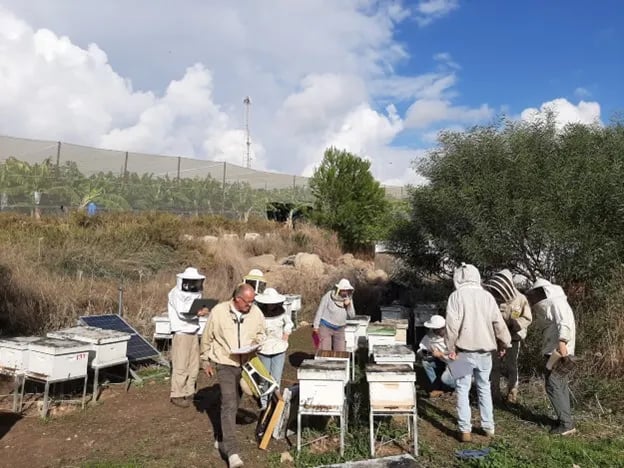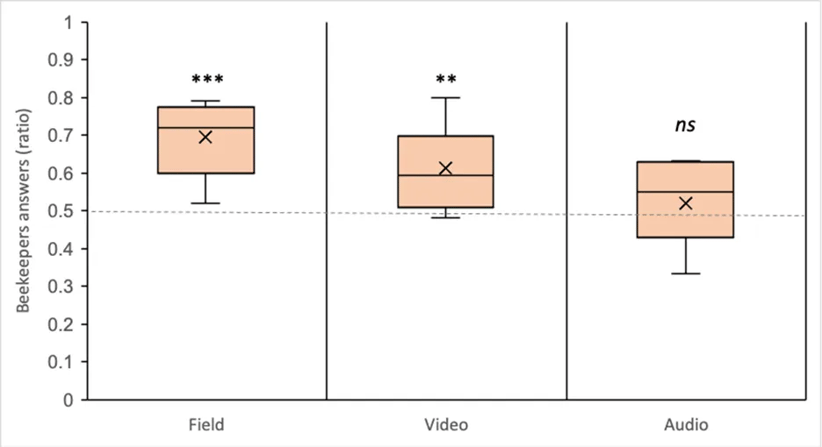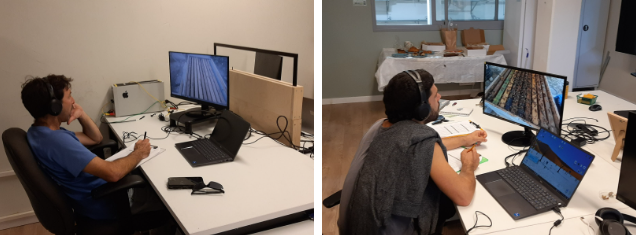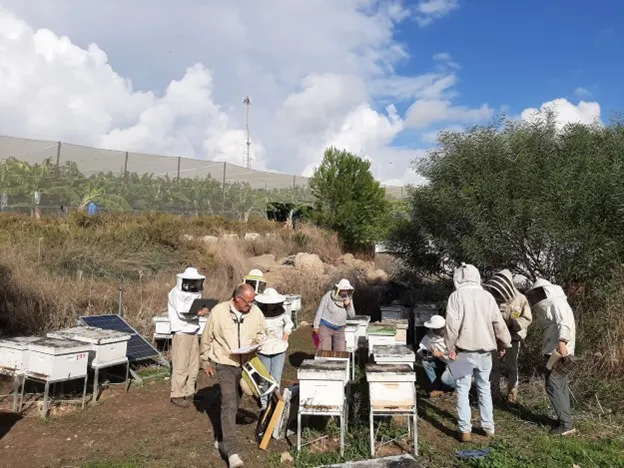In a Nutshell
We studied the ability of professional beekeepers to determine a queenless state in hives under three scenarios:
- Inspection of the hive (all senses + contextual information).
- Video recordings (headphones + screen).
- Audio recordings (headphones).
When physically present during hive inspections, beekeepers correctly identified 70% of the hives (20% better than a random coin flip), while the highest a beekeeper succeeded was above 80%. Beekeepers could also identify the queen’s state using video recordings in the lab with 60% accuracy on average but could not do so using audio recordings alone.
The Whole Story
Professional beekeepers can learn a lot about the status of the bee colony even without opening the hive. Moreover, experienced beekeepers can diagnose various problems by listening to the hive or briefly observing it from above. Some beekeepers claim they can detect the tendency to swarm based on the activity on the balcony, while others perceive the bees’ hunger based on their movements on the top bars of the frames. A beekeeper can determine which flowers were pollinated based on the color of the pellets. In addition to sight, beekeepers rely on smell, sound, and behavioral observations.
This ability to understand bees in a non-invasive manner is fascinating and inspires us at Beewise as we develop robotic hives. Part of our efforts is directed toward performing hive inspections using non-invasive methods with minimal disturbance to the bees. Specifically, we would like to learn about the number of bees, brood quantity, nectar flow, and the status of the queen. So we set out to test beekeepers’ ability to detect queenless hives and possibly learn from how they do it.
For this purpose, we set up three experimental setups: one in the field and two in the laboratory. The field experiment consisted of 25 beehives equipped with sound and temperature sensors. We removed the queens from twelve hives two days before the experiment. On the day of the experiment, we invited five professional beekeepers to asses the hives. We presented the hives to them using a predetermined identical inspection protocol which lasted approximately two minutes per hive and did not allow them to look “into” the hive (Figure 1). The beekeepers were asked to speculate whether a queen was present in the hive and indicate their confidence level in their choice.

Figure 1: Beekeepers inspecting a hive according to the experiment protocol.
In this setup, the beekeepers correctly categorized the presence or absence of a queen ~70% of the time, which is significantly better than a random guess (50%). Interestingly, there was a difference in the beekeepers’ abilities to determine the status of the queen in this situation. Three out of five beekeepers participating in the field experiment answered correctly ~80% of the time, as depicted in the figure below(Figure 2).

Figure 2: The ratio of correct answers (beekeepers or random) for the three experiments (y-axis). The dotted line indicates random choice. The box plot bars represent correct beekeepers’ answers (error bars indicate the minimum and maximum scores, the bars are quartiles, the line in the bar is the median, and the x is the average). A Chi-square test was used to determine the relationship between random choice and the beekeeper’s responses.
To examine the source of the signal used by the beekeepers in the field to diagnose the hive, we created an experimental setup that included the same hive-opening protocol. However, this time it was pre-recorded and presented to them in the lab as audio or video recordings.
We played 28 audio recordings of hives that had a queen or were queenless. We found that the beekeepers could not distinguish the status of the queen based solely on audio recordings and did not perform any better than a random coin flip (Figure 2).

Figure 3: Beekeepers listening to audio recordings of beehives
Next, the beekeepers were presented with video recordings of 28 hives, where again half had queens, and the other half were queenless (Figure 4). Here we found that the beekeepers correctly categorized the presence or absence of a queen 60% of the time (Figure 2). The increase in performance in the video recordings compared to audio demonstrates the importance of visual cues for beekeepers in identifying the status of a queen. Nevertheless, when comparing the video recording experiment to the one in the field, we conclude that there are many other factors that beekeepers take into consideration when they observe the hive. Indeed, we learned from their notes that they considered the weather, general activity in the apiary, availability of flowers, and other factors.

Figure 4. Beekeepers viewing video footage of beehives
This experiment gave us insight into the multi-faceted abilities of professional beekeepers who are minded to the environment, the bees, and their special relationship. We admire their unique set of skills. We sincerely thank the beekeepers who participated in our study: Noga Reuven, Nitzan Lamdani, Avihai Simner, Moshe Koren, and Shaike Weiss. We would also like to thank the beekeepers from Beewise: Michael Erez, Ira Trailer, Ron Sorkein, and Ido Yirmiyahu for participating in this experiment.


.jpg?width=355&height=199&name=DSC00415%20(1).jpg)


.png?width=355&height=199&name=Copy%20of%20The%20Evolution%20of%20Pollination%20(1).png)
Head of Research at Beewise
Leave comment